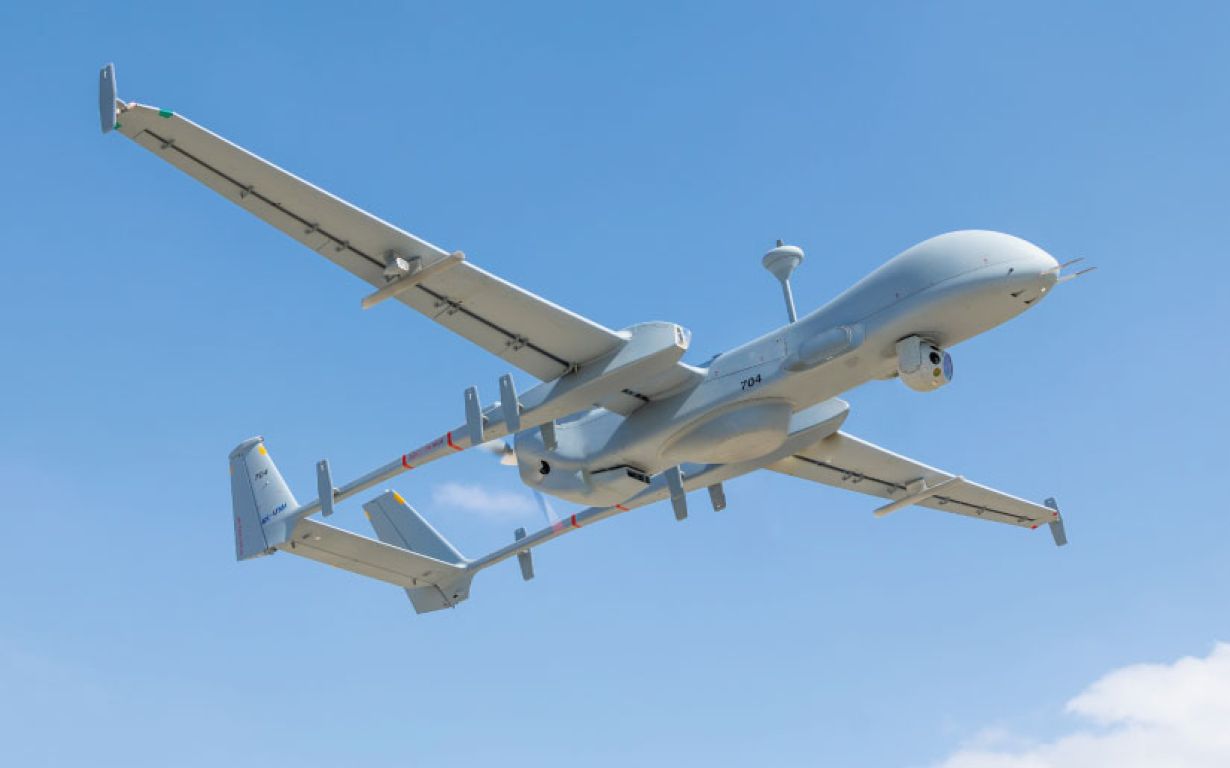India Negotiating With Israel To Manufacture ‘Weaponizable’ Heron Mk2 Drones
India will follow up its ongoing acquisition of 10 Israel Aerospace Industries (IAI) Heron Mk II drones with local production. It’s also negotiating to weaponize its existing fleet of Searcher & Heron Drones.
A proposal to manufacture Heron Mk2 in India under license is also being discussed, Janes learned during Defexpo 2022 held in Gandhinagar, Gujarat, from October 18 to 22.
The Indian Air Force (IAF) and the Indian Army (IA) ordered 10 Heron Mk2 drones from IAI in early 2021 under emergency procurement power granted to the armed forces following the PLA’s incursion across the LAC into India-claimed territory starting February 2020.
The initial plan was reported to lease the drones for three years, but later a decision was taken to purchase them outright.
Heron Mk2
Heron Mk2 is an upgraded variant of the Heron drones already in service with the IA & the IAF.
Fitted with a Rotax 916 iS engine, the Heron MK II can reach an altitude of 35,000 feet, a maximum speed of 140 knots, and remain in the air for 45 consecutive hours.
Due to improved manufacturing technologies, the Heron MK II has a broader and stronger body structure, allowing quick and easy maintenance without adding weight.
Heron Mk2 Specifications
| MTOW: 1,430 kg | Endurance: 45 hours | Loiter Speed: 60 – 80 KTAS |
| Payload: 490 kg | Max Speed: 140 KTAS | Wingspan: 16.6 m |
| Ceiling: 35,000’ | Operating Range: >1,000 km | Overall Length: 8.5 m |
In comparison, MTOW for Heron drones already in service in India is 1,270 kilograms, and the payload weight is 470 kilograms. The length, wingspan dimensions, and other specifications of the two drones are similar.
Heron Mk2 Sensor Payload Options
The Heron Mk2 features better radio, radar, and optical sensors giving it better stand-off capability than its predecessor. The Mk2 can look and listen deep into adversary territory without crossing the border or putting itself in harm’s way of adversary air defenses.
The Mk2 can be configured with different payloads depending on the assigned role. Options include:
EO (Electro-Optical)/IR (Infra-red) sensors under its fuselage provide a real-time battlefield vision under all lighting conditions. Using a satellite communication link, an LRF (Laser Range Finder) facilitates precise distance measurement and real-time targeting information.
An LD (Laser Designator) allows a target to be illuminated for a stand-off strike by a fighter aircraft using laser-guided bombs.
For surveillance, the drone can be fitted with a Synthetic Aperture Radar (SAR) or an MPR (Maritime Patrol Radar).
ELINT/ESM payloads facilitate electronic snooping and spoofing.
Armed Variant
Eventually, the goal is to weaponize the Indian Heron fleet with locally manufactured precision-guided munitions.
India and Israel have been in talks since 2016 to weaponize the existing IAF inventory of Searcher & Heron drones under a top secret and classified program code-named ‘Project Cheetah.’
However, Project Cheetah & a proposal to acquire ten armed Heron TP (see below) made no headway because of Israeli restrictions on the transfer of advanced technologies that would need to be embedded in the drones.
Alluding to the General Atomics pitch to sell MQ-9 Reapers to India, an Israeli source told FlightGlobal in 2017, “The restrictions that the Israeli Ministry of Defense attaches to the export of this advanced UAV are many, and in such a close competition may be a crucial factor.”
Heron TP?
In the past, there were reports in the Indian media that India was acquiring 10 Heron TP drones under a deal estimated to be worth $400 million. The Indian government approved the purchase in September 2015.
In early February 2020, it was reported that IAI & HAL would sign a contract to manufacture Heron TP drones in India. The agreement was to be signed during DefExpo 2020, with 100 drones projected to be manufactured to meet the requirements of the defense services.
The Heron TP is a much larger drone with an MTOW of 5,670 kilograms and a payload of 2,700 kilograms. It can cruise at over 45,000 ft and has an 85-foot wingspan, the same as a Boeing 737 airliner.
The payload carrying capacity of the drone would facilitate arming it with air-to-surface missiles.
The IA & IAF have opted for the Heron Mk 2 instead of the Heron TP. The decision would appear logical, considering India wants to weaponize its inventory of Searcher and Heron drones under Project Cheetah.
Weaponizing Herons and Heron Mk2 would involve developing the same weapons, hardware, and software. Weaponizing Heron & Heron TP would need double the resources.
India will follow up its ongoing acquisition of 10 Israel Aerospace Industries (IAI) Heron Mk II drones with local production.

imrmedia.in



